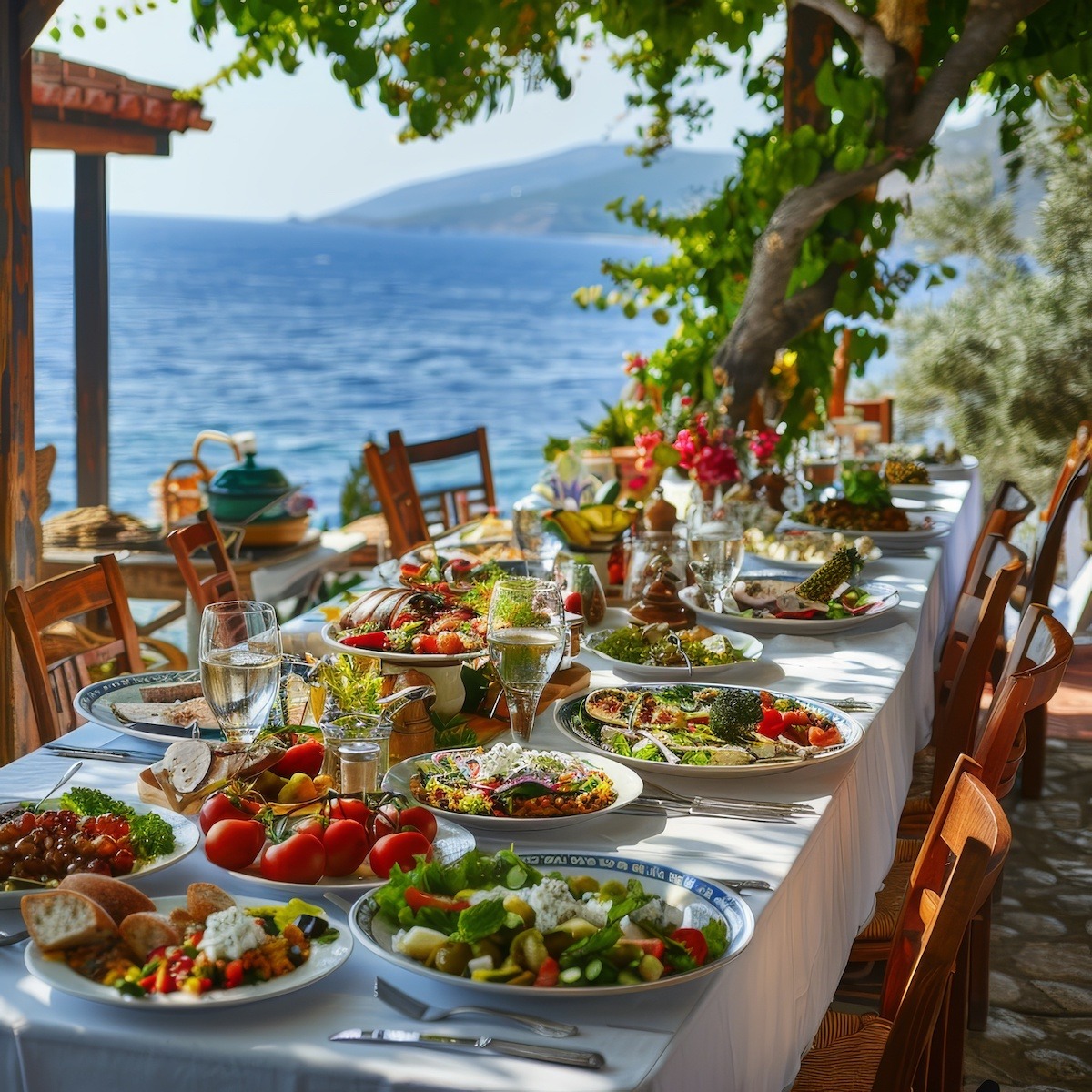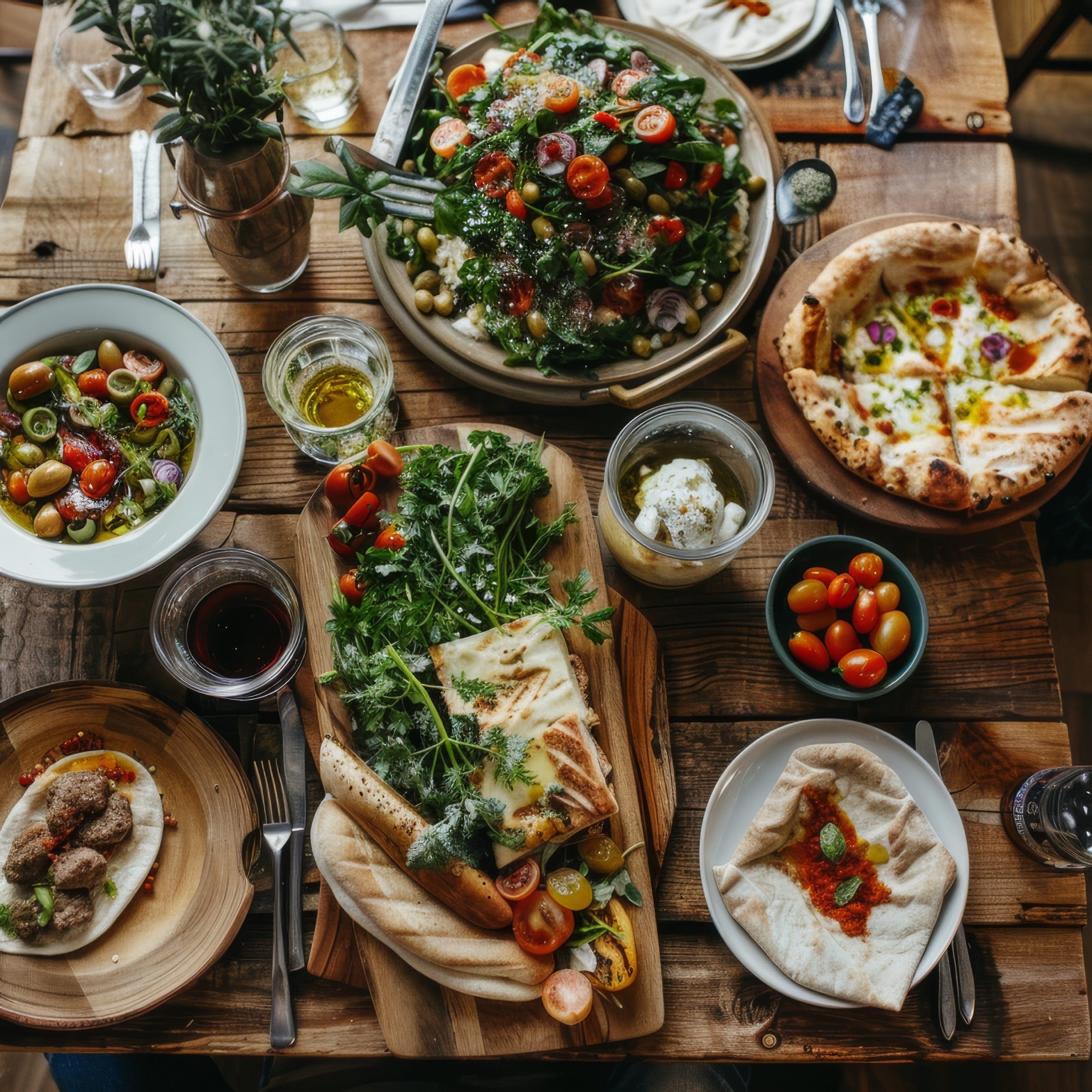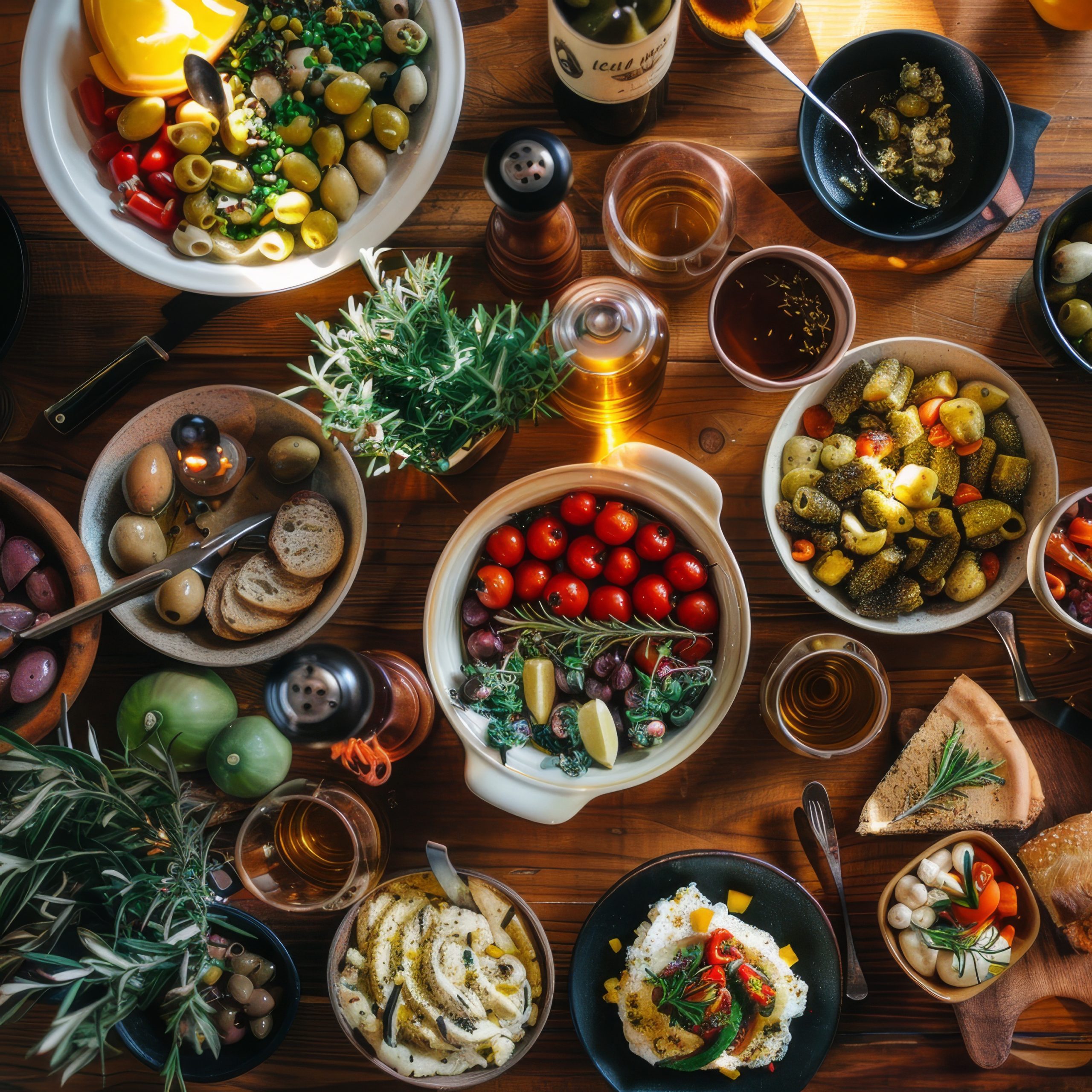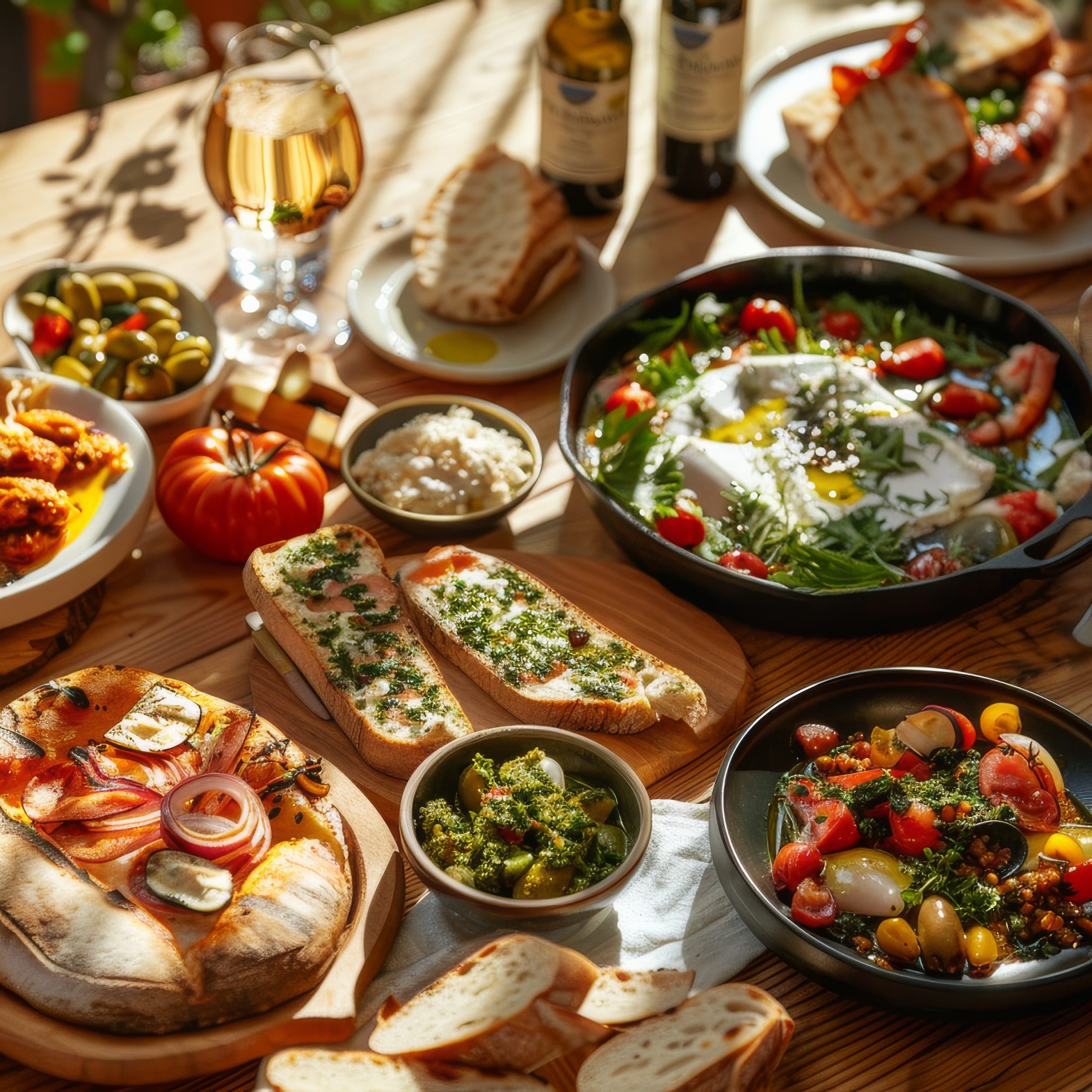

Discover the Flavors: An Introduction to Mediterranean Cuisine
Let’s explore the vibrant flavors and rich cultural tapestry of Mediterranean cuisine, a culinary journey that tantalizes the senses and celebrates the essence of the Mediterranean region. From the sun-drenched coasts of Greece to the aromatic markets of Morocco, this culinary tradition embodies a harmonious blend of fresh ingredients, bold spices, and time-honored techniques.
At its heart, Mediterranean cuisine is defined by its emphasis on wholesome, seasonal ingredients such as olive oil, tomatoes, garlic, and herbs like basil and oregano. These ingredients form the foundation of dishes and reflect the region’s agricultural bounty and Mediterranean climate.
Each country along the Mediterranean coast adds its own unique twist, creating a diverse tapestry of flavors that is sure to excite and intrigue. From Spain’s paella bursting with seafood to Italy’s comforting pasta dishes and the Middle Eastern influences found in dishes like hummus and falafel, every bite tells a story of history, trade, and cultural exchange.
Join me as I delve into the allure of Mediterranean cuisine, exploring recipes, culinary traditions, and the enduring appeal of a diet that offers not just health benefits but also a rich sensory experience. This cuisine’s vibrant flavors and rich cultural tapestry are sure to tantalize your senses and leave you eager to experience more.
What Is the Mediterranean Cuisine?
Mediterranean cuisine refers to the culinary traditions and cooking styles of the countries that border the Mediterranean Sea. This region includes Southern Europe (such as Spain, Italy, Greece, and southern France), North Africa (Morocco, Algeria, Tunisia, Libya, and Egypt), and the Eastern Mediterranean (Turkey, Lebanon, Syria, Israel, and Palestine).
Mediterranean cuisine is characterized by its emphasis on fresh, seasonal ingredients. It is known for its abundant use of olive oil, fresh vegetables, fruits, seafood, grains (especially wheat and barley), nuts, and herbs. The cuisine is also notable for its moderate consumption of dairy products, wine, and other fermented beverages.
Key elements of Mediterranean cuisine include:
- Olive Oil: Used liberally in cooking and as a dressing.
- Fresh Vegetables and Fruits: Tomatoes, eggplants, zucchini, peppers, citrus fruits, and more.
- Seafood: Mediterranean cuisine features a variety of fish and shellfish.
- Herbs and Spices: Basil, oregano, rosemary, thyme, garlic, and saffron are commonly used.
- Grains: Wheat, barley, and rice form the basis of many dishes.
- Legumes: Chickpeas, lentils, and beans are staples.
- Wine: Red and white wines, consumed in moderation, often accompany meals.
Mediterranean cuisine is celebrated for its delicious flavors and health benefits, attributed to the abundance of fresh ingredients and balanced nutritional profile.
History

The history of Mediterranean cuisine is a rich tapestry woven from the diverse cultural, agricultural, and trade influences of the civilizations that have flourished around the Mediterranean Sea for thousands of years. Here are some critical points in its development:
Ancient Civilizations
- Egyptians: The use of grains, legumes, and vegetables dates back to ancient Egypt, where bread and beer were staples.
- Greeks: Ancient Greece introduced the concept of symposiums, where people gathered to share food and wine. Olive oil, bread, and wine formed the basis of their diet, and they heavily used herbs like oregano and thyme.
- Romans: The Romans expanded on Greek culinary traditions, introducing new ingredients and techniques. They were known for their banquets and the use of ingredients such as garum (a fermented fish sauce), olives, and various meats.
Middle Ages
- Byzantine Empire: As a successor to the Roman Empire, Byzantine cuisine retained many Roman elements and introduced Middle Eastern influences, including spices like cinnamon and cloves.
- Islamic Golden Age: The expansion of the Islamic Caliphates into the Mediterranean brought new ingredients and culinary techniques from the Middle East, including rice, sugar, and various spices. The Moors in Spain, for example, introduced almonds, citrus fruits, and saffron.
Renaissance and Beyond
- Italian Renaissance: Italy became a culinary hub with the development of pasta and the refinement of culinary techniques. The discovery of the New World introduced tomatoes, potatoes, peppers, and chocolate to Europe.
- Ottoman Empire: The Ottomans influenced the cuisine of the eastern Mediterranean with dishes like kebabs and the use of yogurt and eggplant.
Modern Era
- Trade and Exploration: The Mediterranean has always been a crucial trade route, facilitating the exchange of ingredients and culinary ideas. This exchange has enriched the local cuisines and introduced a variety of flavors and techniques.
- Colonial Influence: European colonialism brought additional influences and ingredients from Africa, Asia, and the Americas, further diversifying Mediterranean cuisine.
Contemporary Mediterranean Cuisine
Today, Mediterranean cuisine is celebrated for its health benefits. It is characterized by the Mediterranean diet, which emphasizes plant-based foods, healthy fats like olive oil, lean proteins, and moderate wine consumption. The cuisine reflects the region’s rich history and the blending of various cultural influences over millennia, creating a vibrant and diverse culinary tradition that continues to evolve.
Ingredients

Mediterranean cuisine is renowned for its emphasis on fresh, seasonal, and wholesome ingredients. Here are some essential ingredients that form the foundation of this culinary tradition:
Olive Oil
- Olive Oil: A cornerstone of Mediterranean cooking, used in everything from frying to dressing salads.
Vegetables and Fruits
- Tomatoes: Fresh, sun-dried, or canned tomatoes are used in sauces, salads, and soups.
- Eggplants: Often grilled, roasted, or used in stews.
- Zucchini: Used in salads, stews, and as a base for dishes like ratatouille.
- Bell Peppers: Fresh, roasted, or grilled, they add color and flavor to many dishes.
- Leafy Greens: Such as spinach, arugula, and various lettuces.
- Citrus Fruits: Lemons, oranges, and limes for zest, juice, and garnish.
Herbs and Spices
- Basil: Often used in Italian and Greek dishes.
- Oregano: Common in Greek and Italian cuisines.
- Rosemary: Used for flavoring meats and vegetables.
- Thyme: A versatile herb used in many Mediterranean recipes.
- Garlic: A staple in countless Mediterranean dishes.
- Parsley: Frequently used as a garnish and flavor enhancer.
- Saffron: Especially in Spanish dishes like paella.
Proteins
- Seafood: Fish (anchovies, sardines, and tuna), shellfish, and octopus.
- Legumes: Chickpeas, lentils, and various beans are foundational, especially in Middle Eastern cuisine.
- Poultry and Lamb: Common meats, often grilled or used in stews.
- Nuts and Seeds: Almonds, pine nuts, and sesame seeds.
Dairy
- Cheese: Feta, halloumi, ricotta, mozzarella, and Parmesan.
- Yogurt: Especially in Greek and Turkish cuisines, it is used in sauces, desserts, and as a standalone dish.
Grains
- Wheat: Used in bread, pasta, and couscous.
- Rice: Integral to dishes like Spanish paella and Italian risotto.
- Barley: Often used in soups and salads.
Additional Staples
- Wine: Both as a beverage and a cooking ingredient.
- Honey: Used in desserts and as a sweetener.
- Vinegar: Particularly wine vinegar and balsamic vinegar, for dressings and marinades.
These ingredients come together in various combinations to create the diverse and flavorful dishes that define Mediterranean cuisine.
What is the Mediterranean Diet

The Mediterranean Diet is a nutritional pattern inspired by the traditional dietary habits of people living in countries bordering the Mediterranean Sea, such as Greece, Italy, and Spain. It emphasizes whole, minimally processed foods and is celebrated for its health benefits, particularly heart health and longevity.
Key Components of the Mediterranean Diet:
- High Consumption of Vegetables, Fruits, Legumes, and Nuts: These plant-based foods are the foundation of the diet, providing essential vitamins, minerals, and fiber.
- Whole Grains: Whole wheat, barley, oats, and brown rice are preferred over refined grains.
- Healthy Fats come primarily from olive oil, which is used for cooking and dressings, as well as avocados, nuts, and seeds.
- Moderate Fish and Poultry: Fish, especially fatty fish like salmon and sardines, is consumed regularly, while poultry is eaten more often than red meat.
- Limited Red Meat: Red meat is eaten sparingly, and processed meats are minimized.
- Dairy: Mostly in cheese and yogurt, consumed in moderation.
- Wine: Typically red wine, enjoyed in moderation, usually with meals.
- Herbs and Spices: These are used instead of salt to flavor foods.
Health Benefits:
The Mediterranean Diet has numerous health benefits, including reduced risk of cardiovascular disease, improved cholesterol levels, better weight management, and lower incidence of type 2 diabetes and certain cancers.
Popularity Timeline:
- 1950s and 1960s: The diet began gaining recognition through the work of Ancel Keys, an American scientist who studied the eating patterns of people in Southern Italy and Greece. His research linked the Mediterranean diet to lower rates of heart disease.
- 1990s: The diet gained widespread popularity when the results of the Seven Countries Study, initiated by Keys, were published, highlighting the health benefits of Mediterranean eating patterns.
- 2000s to Present: The diet’s popularity grew with endorsements from health organizations and numerous studies validating its health benefits. It has been promoted by various institutions, including the World Health Organization (WHO) and the United Nations Educational, Scientific and Cultural Organization (UNESCO), which recognized the Mediterranean diet as an intangible cultural heritage.
Today, the Mediterranean Diet is celebrated globally as a model for healthy eating. It combines delicious, diverse, and nutritious foods that promote overall well-being.
 Print
Print




